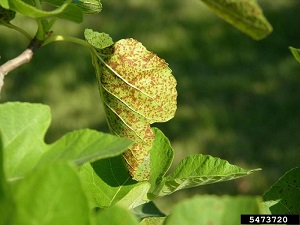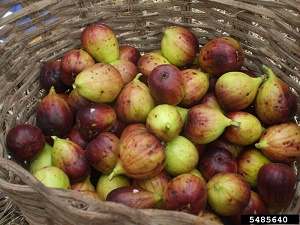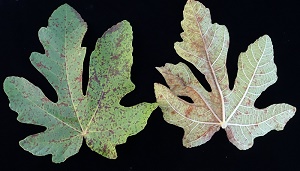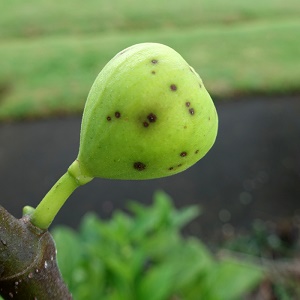| Fig Diseases - Insects | ||||||||||||
|---|---|---|---|---|---|---|---|---|---|---|---|---|
|
Back
to Fig Page  Fig. 1  Fig rust, fruit symptoms  Fig. 2  Pustules of fig rust on the lower leaf surface  Fig. 6  Cercospora leaf spot (Cercospora fici). Symptoms on Ficus carica.
|
Fig trees are
a moderately sustainable crop but suffer from a number of animal and
disease pests . Fig tree roots and fruit are a favorite food of
birds, gophers, rabbits, and squirrels. Root knot nematodes can also be
a limitation for fig trees planted in sandy soils but are not usually a
problem in fertile or loamy soils. Organic amendments or mulches
reduce nematode damage. A number of insects and diseases can attack fig
fruit cultivars with an open eye. 1 Fig Rust Caused by Cerotelium fici The most common disease of fig in the southeastern United States is the fig rust (Cerotelium fici). Fig rust turn leaves brown, can cause defoliation and premature ripening of the fruit, and decreases cold tolerance. This disease can be controlled by a 5-5-50 Bordeaux spray (copper sulfate, lime and water) applied every two to three weeks during the growing season, from April to November. 1
Fig. 3. Rust of fig leaves in Hawai'i (Mānoa valley, island of Oahu) caused by the plant-pathogenic fungus, C. fici Fig. 4,5. Fig rust. Pathogen: C. fici Further Reading Fig Rust in Hawai'i, University of Hawai'i at Mānoa pdf Cercospora leaf spot (Fig. 6) Caused by Cercospora fici Cercospora leaf spot fungus (Cercospora fici), causes branch terminals to turn black and die. 1
Fig. 7,8. Symptoms on leaf and fruit Further Reading Cercospora Leaf Spot of Fig, Florida Department of Agriculture and Consumer Services pdf Another fig disease include Botrytis cinerea (fungus) which also causes branch terminals to turn black and die. Thread blight (Pellicularia koleroga) results in necrosis of stems and matted foliage. Botryosphaeria dothidea (fungus) causes necrosis of leaves and stems. Rhyzopus stolonifer (smut) causes fruit drop of cultivars with an open eye. Fusarium spp. and Aspergillus niger are fungi that attack ripe fruit. 1 Although many diseases attack figs, most figs are grown in homeowner settings and do not receive pesticide sprays. The most common insect pests are mealy bug, three-lined fig borer, and ants. The application of insecticide is seldom warranted. Please contact your local UF/IFAS Extension agent for spray recommendations. 1 |
|||||||||||
| Bibliography 1 Sarkhosh, Ali, and Peter C. Andersen. "The Fig." Horticultural Sciences Department, University of Florida, IFAS Extension, HS27, Original Pub. Mar. 1994, Revised Nov. 2009, June 2016, and Oct. 2019, EDIS, edis.ifas.ufl.edu/mg214. Accessed 4 Mar. 2017, 15 June 2020. Photographs Fig. 1,3,4,5 Nelson, Scot, C. "Rust of fig leaves in Hawai'i (Mānoa valley, island of Oahu) caused by the plant-pathogenic fungus, Cerotelium fici." Flickr, 2012, (CC BY-SA 2.0), flickr.com. Accessed 5 Mar. 2017. Fig. 2 Ferrin, Don. "Pustules of fig rust on the lower leaf surface." Louisiana State University Agricultural Center, 2012, Bugwood.org, (CC BY 3.0 US), bugwood.org. Accessed 5 Mar. 2017. Fig. 6,7,8 Hamann, Jonas Janner. "Cercospora leaf spot (Cercospora fici) Heald & F.A. Wolf." Universidade Federal de Santa Maria, 2012, Updated 2016, Bugwood.org, (CC BY 3.0 US), bugwood.org. Accessed 5 Mar. 2017. Published 5 Mar. 2017 LR. Last update 23 June 2020 LR |
||||||||||||




